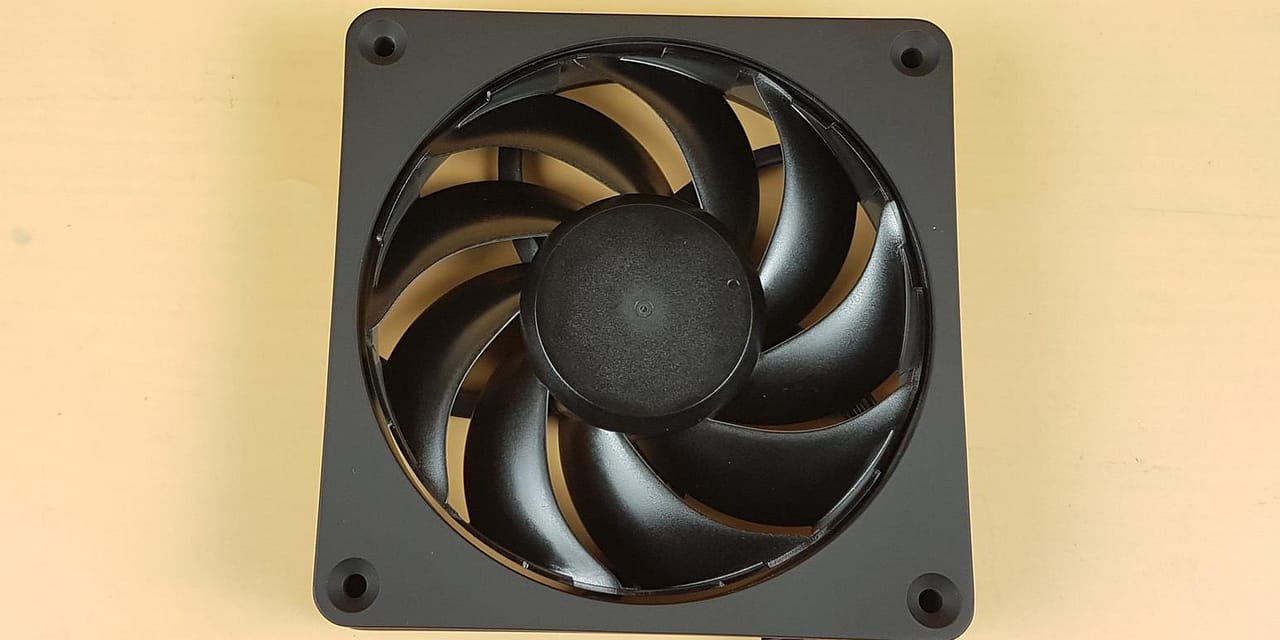Introduction
All metal-made fans! That was quite a theme back at Computex 2023 when Alphacool showcased the Apex Stealth Fans. Though a lot has been said and much fuss surrounds the specifications and initial test data, Alphacool seems to have overcome all odds and has forwarded with the sampling of the fans.
I have got two fans for the testing and honestly speaking, I thought I had done the content already. Apologies. Anyhow, I am taking a look at the 3000 RPM version of these fans. These fans are available in 2000 RPM and 3000 RPM variants in 4 colors. These colors are:
- Matte Black
- Chrome
- White
- Gold
Alphacool’s marketing has been quite aggressive about these fans. One such statement is, “The power of heavy metal with the sound of silence”. This tells a lot as well. Alphacool is confident and excited as well for these fans. They should be since they are coming out with a new design altogether particularly using a completely decoupled impeller from the main metal frame. This includes the bearing and motor as well. These fans are marketed as radiator cooling fans where the requirement is high airflow while maintaining high static pressure. One can put these to PC Case ventilation as well.
The Apex Stealth Metal 3000 RPM Black fans retail at €29.98 with three fans set retailing at €80.94.
Apex Stealth Metal 3K Specifications
You can see that Alphacool has mentioned die-cast zinc for the construction of metal frames. These fans use Hydro Dynamic Bearings. Hail Hydra! The Hydrodynamic bearings are based on non-contacting operation which in theory would provide infinite life depending on the design elements including Viscous Fluid, Relative Motion of the surface, and converging geometry. Anyhow, non-contacting operation seems to be the main reason we are seeing these bearings in this decoupled design.
Dimension
I have taken this picture from the Alphacool website. It shows the dimensions of these fans to be 120x120x25.5mm. The gap between any two mounting holes is 105mm. The fans’ cable length is 140mm. The extension cable has a length of 500mm which is good enough.
Packaging and Unboxing
The fan is shipped inside a standard cardboard box and Alphacool has kept the standard brown color intact. The branding and other data is printed right over this brown color box.
Looking at the backside, you will find a sticker showing the speed and color of the fan inside the box.
Kudos to some nice presentation! The fan is placed inside a semi-transparent container. There is an accessory box that has the bundled mounting hardware.
Contents
Alphacool has provided the following inside the box:
- 1x Apex Stealth Black Fan
- 1x User Guide
- 1x PWM Extension Cable
- 1x Fiber Cloth
- Various Screws
- 4x Stealth Mounting Nuts for Case mount
One thing you would notice is the three different thread-size screws provided with the box. Alphacool was paying attention to the details. Since the radiator manufacturers use different threading on the mounting holes which may not be compatible with screws provided with the fans (though these radiators are supplied with their fan screws), hence Alphacool has taken care of it by providing the following threaded screws:
- M3
- M4
- 6-32 UNC
The above picture shows the thread length and pitch of these screws.
The user guide is thorough.
Close Look
It is time to take a look at these fans for their design aspects.
As you can see in the above picture, there are 9x blades in black. These are connected to the outer ring that also rotates along with these blades. The complete assembly is black. The diameter is relatively large for a non-RGB fan and I am not sure about the reason. Maybe it has to do with the structural stability. You can also see that the tips of the blades have raised surfaces that have an inset design integrated into the outer ring. I am not sure if this has to do with maximizing airflow or reducing vortices during the operation. The frame is made of die-cast zinc material as mentioned above.
The cool aspect is the design of impellers, bearings, motor, and in fact, the complete suspension which is completely decoupled from the main frame. How Alphacool has achieved this is a mystery.
Now, we are taking a look at the backside of the fan. I thought that maybe the arms assembly on the backside would be connected to the mainframe but I was wrong. Complete suspension is decoupled. How!!!!!!!!!! Anyhow, there is a 5-arm assembly. Take a look at the design of these arms.
They have a slope design. They would disrupt the airflow coming through the fan but in a particular manner that would spread around. This is not a focused flow design. This seems to be a spiral loop design.
There is a manufacturing date on the backside as well. These fans are rated for 0.5A at 12VDC generating 6.60W power based on a maximum of 0.55A, which is quite high. Normally, your fan header on the motherboard is typically rated for 1A at 12VDC unless stated otherwise. This would mean you can only connect one of these fans to such fan headers. However, if the fan header has a rating of 2A or 3A which is now becoming on modern high-end motherboards, you can connect 2-3 Apex Stealth fans to such headers depending on the power rating. However, don’t overload the fan header as it would cause damage to the motherboard as well as to the fan.
I am showing a mounting corner of the Apex Stealth Fan. Since the complete suspension is decoupled there was no need for an anti-vibration pad. This is a sunken design where the screws would sit in flus to the frame or border of the housing. This would not only look cool but also reduces the overall thickness of the fans with screws.
However, there is one distinction here. Alphacool has mentioned that they have used a special damping system between the metal frame and the fan suspension. This damping system absorbs all the vibration.
I am showing one of the four sides of the metal frame. All sides have the same design and layout except the one being shown as it has a power cable. The two-part metal frames are internally connected which is again a mystery. We can see that the main inner housing has a ring design. This ringed component hides the inner components.
Speaking of the power cable, Alphacool has routed this 140mm cable in such a manner that one end has a 3-pin socket and the other end has a 4-pin PWM connector. The provision of the socket gives these fans daisy-chain capability. The daisy-chained fans can then be controlled using a single extension cable.
I am showing both connectors in the above picture.
I was trying to show a clearance between the outer ring and the metal frame but it was a failed attempt. The tip clearance is not that narrow but I think it is a part of the total suspension being completely decoupled. Alphacool has mentioned that this is a closed design hence the tips of the blades would not flutter particularly at high speeds. This can enhance the durability of the fan.
Since this is a closed design, the blade tips don’t flutter at high speed which would help with the durability of the fan.
The above picture shows the internal layout of the Apex Stealth Metal fans. There is a large-size rubber gasket that sits over the fan suspension body. This absorbs the vibration. We can now understand that the main fan suspension sits over the back side and has its frame with 5-arms. There is another ring rubber gasket that sits below the backside of the fan body. Now, we can see how the cable is routed out towards the metal frame.
The salient specifications include:
| Dimension | 120x120x25.5mm |
| Speed | 400~3000 RPM ±10% |
| Airflow | 70.98 CFM |
| Static Pressure | 4.23 mmH₂O |
| Max Volume | 40.1 dBA |
| Bearings | Hydro Dynamic |
| MTBF | 100,000 |
| Starting Voltage | 6VDC |
| Nominal Voltage | 12VDC |
| Power Consumption | 6.60W |
| Current Rating | 0.50A (Max 0.55A) |
Thermal Testing
The following configuration is used for the thermal testing: –
- AMD Ryzen 7950X [PBO Advanced]
- GIGABYTE X670E AORUS MASTER
- Kingston Fury Renegade 32GB DDR5 Kit 6400MHz CL32
- EK-AIO Nucleus CR240 DARK
- Sabrent Rocket 4 Plus 2TB NVMe SSD
- ASRock Phantom Gaming RX 7600 OC [For Display]
- CORSAIR AX1200i Platinum PSU
- Open-air Test Bench
Here is the settings table for testing:
| All Cores | Auto |
| VCore (V) | Auto |
| PBO | Advanced |
| PPT | 200,000mW |
| TDC | 408,000 |
| EDC | 640,000 |
| Boost Clock Override | +75Hz |
| Platform Thermal Throttle | Auto |
| Efficiency Curve | -20mV All Cores |
| Thermal Paste | Noctua NT-H1 |
| Test Run Time | 30 minutes CINEBENCH R23.2 |
| Idle Time | 10 minutes |
| Fan/Pump Speed | 100% PWM Duty Cycle |
| Monitoring Software | HWInfo64 |
Let’s first take a look at the PWM range and sound profile of these fans:
| PWM (%age) | Speed (RPM) | Sound Output (dBA) |
| 5 | 0 | 37 |
| 10 | 296 | 37.2 |
| 20 | 641 | 37.2 |
| 30 | 958 | 37.2 |
| 40 | 1280 | 37.4 |
| 50 | 1580 | 38.4 |
| 60 | 1869 | 39.9 |
| 70 | 2177 | 43 |
| 80 | 2428 | 45.4 |
| 90 | 2710 | 47.8 |
| 100 | 2973 | 50.4 |
| 64 | 2033 | 40.8 |
These fans were silent until they crossed 50% PWM after which you can start hearing them but they are still silent. They are quite good to 70% PWM range in terms of sound output. However, after they are loud and at full speed, they are indeed the loud fans in your room. I wanted to test these fans at the 2000 RPM mark for comparison with Noctua NF-A12x25 PWM fans. I got this speed at the 64% PWM range where they were making 40.8 dBA sound output.
Usually, I prefer using a 360mm cooling solution for the evaluation of the fans but since we got only two fans I was left with no choice but to test these fans using a 240mm AIO which is one of the best performance 240mm AIO in the market at the time of this testing. It is EK-AIO Nucleus CR240 DARK.
I have used EK-Loop FT 120mm and Noctua NF-A12x25 PWM fans in this comparison. The below table compares the specifications of these fans for ready reference.
| Apex Stealth 3000 RPM | EK-Loop FT 120 | Noctua NF-A12x25 PWM | |
| Dimension | 120x120x25.5mm | 120x120x25mm | 120x120x25mm |
| Speed | 400~3000 RPM ±10% | 550~2300 RPM ±10% | 450~2000 RPM ±10% |
| Airflow | 70.98 CFM | 72 CFM | 60.09 CFM |
| Static Pressure | 4.23 mmH₂O | 2.7 mmH₂O | 2.34 mmH₂O |
| Max Volume | 40.1 dBA | 36 dBA | 22.6 dBA |
| Bearings | Hydro Dynamic | Fluid Dynamic | SSO2 |
| MTBF | 100,000 hours | 60,000 @ 25°C hours | ˃ 150,000 hours |
| Voltage Rating | 12VDC | 12VDC | 12VDC |
| Power Consumption | 6.60W | 3W | 1.68W |
| Current Rating | 0.50A (Max 0.55A) | 0.25A | 0.14A |
I have used the AMD AM5 platform where the CPU will operate at 95°C to provide maximum clock boost headroom. It was of no use testing at stock hence I set up an advanced PBO configuration (mentioned above) to test the fans by still pushing them to the boundary but getting comparable results for graphs.
I have included the noise output along with the attained speed and Cinebench R23.2 Multi CPU score in the graph in addition to the thermals. I have reported absolute temperatures since the variation in the ambient temperature during the tenure of testing was within 1°C.
You can see that both EK and Alphacool fans were in a tie while sitting on the top in terms of the thermal performance but there are more variables there to account for. The speed range of EK fans is 2300 RPM whereas Alphacool fans are 3000 RPM which is quite a difference. Second, EK fans gave much better sound output compared to the Alphacool fans. Hence, this result favors the EK fans over the Alphacool Apex Stealth Metal fans.
The Noctua fans while operating at a much lower 1997 RPM speed and producing an impressive 40.1 dBA were 1.1°C and 1.2°C behind the Alphacool and EK fans respectively. All fans provide over 38000 scores. This makes Noctua fans the overall winner of this round.
Now come to the second phase where I reduced the speed of the Alphacool Apex Stealth Metal fans to nearly 2000 RPM (64% PWM) for some handy comparison with the Noctua fans. Now the equation gives more favor to the Noctua fans with a good difference of 2°C over the Apex Stealth Fans though the sound output was almost in the same range. Even, the winner of the second phase is Noctua NF-A12x25 PWM fans.
While I applaud Alphacool for a new design in the fans which is a rare thing given how close the technologies are while designing these fans, the result is conclusive that Noctua NF-A12x25 PWM fans are still overall better performers.
Conclusion
Fans that are made of metal! There is no limit to human intellect when it comes to innovation and Alphacool has come out with a new breed and design that drastically differs from the competition. Noctua so far has been the leader in fans’ innovation and new design but seems like Alphacool has also joined the race.
Say hello to the Apex Stealth Metal fans. Apex and Core are two major brands from Alphacool where Core is more mainstream whereas Apex is the flagship series of the products. Even since the Computex 2023, these fans have made huge waves until they came out and we saw quite a stir in terms of what Alphacool showed and how these fans perform but Alphacool has addressed the issues, and corrected the numbers.
Alphacool claims that they are high-air flow fans with good sound output. While I am not well equipped to verify the airflow which in my opinion seems low I have tested the sound profile of these fans in the testing in addition to the basic thermal testing.
The main frame of these fans is made of metal using die-cast zinc. The complete fan suspension is surprisingly decoupled from the main frame and this is simply marvelous. How they have achieved this is a mystery though. Despite all this, it is a closed design which has its benefits.
There is a vibration-damping system that sits between the complete fan suspension body and the metal frames. The metal frame is a two-part design and they are internally connected. This is again a mystery how they were able to achieve this but they have for sure surprised us.
The impellers count is 9 on each fan and there is an outer ring to which these blades are connected. That ring also spins along with the blades. The center of these fans is quite large for a non-RGB fan. Alphacool has opted for Hydrodynamic bearings which makes sense since these bearings have non-contacting operation. These bearings give the Apex Stealth fan a healthy 100,000 hours of MTBF.
These fans are available in 2000 and 3000 RPM speed variants and there are four colors to select from including Matte Black, Gold, White, and Chrome. These fans weigh a ton coming from the metal construction. However, the fan suspension body is made of plastic.
I have tested the 3000 RPM version. These are rated to generate 70.98 CFM while maintaining 4.23 mmH₂O static pressure and operate at 40.1 dBA. These fans are rated for 12VDC with a maximum current of 0.55A and a typical current of 0.5A. The power consumption comes to a whopping 6.60W. This is quite a high power consumption and reminds me of Thermalright TF143 fans with 7.2W consumption.
This has implications for your motherboard. If your motherboard has 1A rated fan header, you can connect only one Apex Stealth fan on this header since its maximum power rating would be 12W and Apex Stealth is already taking more than half of it. But if your fan header is rated for 2A then you have 24W headroom to work with and can connect up to 3x Apex Stealth Fans on that header.
Alphacool has included 3x sets of fan screws for the radiators that may have different thread sizes. These are M3, M4, and 6-32 UNC type thread size screws. Though Alphacool has covered the commonly used threads on the PC industry radiators, I contend that the majority of the radiators and the coolers come with their own fan screws so as such these would not be required. But there may be one reason for this design. Alphacool is using a sunken design on the mounting holes where the screw head would sit flush with the body of the frame. This would make a better sense for these screws giving a broad compatibility with the radiators. You can install these fans for case ventilation for which 4x nuts are also provided making a convenient installation.
Another salient mention here is that these fans come with a 140mm cable per fan and this cable has a standard 4-pin PWM connector as well as a 3-pin socket. This would give the handy functionality of daisy-chaining and reduce the cable clutter (keep in mind the power rating). These daisy-chained fans can then be connected to the motherboard using a 500mm extension cable that has a standard 4-pin PWM connector.
These fans have a zero RPM mode which is dependent on the supported motherboard. They feature an auto-restart function as well as PWM signaling.
Now coming to the testing of these fans, up to 70% PWM, they remain silent though after 50% you would start hearing them. This is a good achievement. However, these fans are loud after 70% PWM range and even louder at full speed. Here is a catch, they may be loud but they sound better than the other fans on the market. This is how I can best describe these fans. There is no humming or high-pitch shrill noise at full speed.
Are these Noctua Killer? My simple answer is no. In my testing using a 240mm AIO (EK Nucleus CR240 Dark), these fans were 1.1°C better than the Noctua NF-A12x25 PWM fans but this performance has come at the cost of 50.4 dBA sound output compared to 40.1 dBA on the Noctua fans. Then making these Apex Stealth fans operate at the 2000 RPM mark to match the speed of the 2000 RPM of Noctua fans, these fans could not keep up and were behind the Noctua fans by 2°C. So, in my opinion, Noctua NF-A12x25 PWM fans are more favorable though Apex Stealth held on their own ground. I would want to try the 2000 RPM version of these fans for further comparison. I wanted to test these fans on a custom loop setup for more better comparison but my poor health did not allow me to do that. Apology for that.
Anyhow, at full speed, these fans were highly competitive against the EK-Loop FT 120mm fans but again there was a large noise output gap between both types of fans that favored the EK fans since they were operating at 2300 RPM compared to 2973 RPM on Apex fans. This indicates that Apex Stealth fans might not be generating enough airflow to gain that very competitive edge that they deserve.
A single 3000 RPM Apex Stealth Fan has an MSRP of €29.98 with three fans set retailing at €80.94. Alphacool is giving a 5-year warranty on these fans which is a plus though Noctua offers a 6-year warranty but EK is giving only a 2-year warranty which is quite low.
Pros
- Thermal Performance
- Fresh Design
- Decoupled Suspension
- Metal Frame
- Hydrodynamic Bearing with 100,000 MTBF
- Daisy-Chain Function
- Multi-thread Screws
- Better noise profile at 2000 RPM
- Better Sounded Fans
- 5-Year Warranty
Cons
- Fans are loud at full speed
- High Power Consumption





























